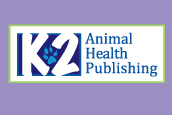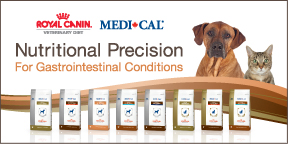
![]()

WINNIPEG, MB − When discussing a pet food with a client, the first place to look is at the American Association of Feed Control Officials (AAFCO) nutritional adequacy statement, because it can tell you a lot about the food, explained Nicole Andrews, DVM, speaking at the MAHTA 28th Annual Conference and Trade Show. The basis of the nutrition claim is documented on the pet food label by either the formulation method or feeding trial method.
Formulation method
Simply a laboratory nutrient profile analysis
Doesn’t require feeding or digestibility trials
Less expensive, less time consuming
Doesn’t account for acceptability of food or nutrient bioavailability
This method is recognized on a label by a statement such as “Product X is formulated to meet the nutritional levels established by the AAFCO Dog Food Nutrient Profiles for (lifestage)”
Feeding trial method
Manufacturer must perform an AAFCO-protocol feeding trial using the food as the sole source of nutrition
Preferred method (Gold Standard)
Documents how an animal performs when fed a specific food
Feeding trials can result in adequacy claims for 4 categories including: 1) gestation and lactation, 2) growth, 3) maintenance, and 4) complete for all life stages. A food that has successfully completed a sequential growth and gestation/lactation trial can make a claim for all life stages
The required wording for labels that have passed these tests is: “Animal feeding tests using AAFCO procedures substantiate that ________ provides complete and balanced nutrition for (lifestage)”
The guaranteed analysis
The guaranteed analysis includes crude protein (minimum), crude fat (minimum), crude fibre (maximum), and moisture (maximum). The guaranteed analysis is a general idea of the nutrient content of a food but is of little value in comparing foods because specific nutrient contents are not given and values are listed on an “as is” basis. For instance, while crude protein is an accurate index of protein quantity, it does not indicate protein quality.
Ingredient panel
The ingredient statement must be shown on the label and includes a list of ingredients (which must conform to AAFCO names), in descending order by weight. Dr. Andrews said that because ingredients are listed on an “as is” basis, the interpretation of ingredient lists is difficult since many key ingredients are added with different moisture contents. Because meats contain more moisture, they may be listed first on the ingredient list, although the primary component of the food might be a mixture of grains. Additionally, the ingredient statement does not provide information about the quality of ingredients.
Ingredient splitting is fairly common in the pet food industry and has no impact on the quality of the food. By splitting an ingredient into several different forms, it allows a meat source to appear first or earlier on the ingredient panel.
Corn
One of the most common pet food myths is that corn is a “bad” ingredient. In reality, corn is a great nutritional package. It supplies some of nature’s antioxidants, which have been shown to reduce the risk of some chronic diseases such as cancer, heart disease, arthritis, strokes, cataracts, and slow the aging process.
Corn is also a rich source of fatty acids, especially linoleic and linolenic acids which help to nourish the skin and coat. These essential fatty acids also serve important roles in the immune system and central nervous system.
Finally, corn is responsible for less than 2% of the reported allergies in dogs. In fact, beef, dairy and wheat comprise over two-thirds of the food allergies in dogs. These, plus lamb, chicken, chicken egg, and soy together, comprise 93% of the food allergies in dogs. For cats, beef, dairy and fish together comprise 80% of the food allergies. Studies show that corn causes no more food allergies than any other grain.
By-products
Reputable pet food companies should only be selecting and using by-products that add great nutritional value and palatability. The by-products that a reputable pet food manufacturer selects for use in pet foods allow the addition of nutrient-rich organ meats, while avoiding excess minerals from bones that are found in less-expensive meat meals.
Meat – first foods
Dr. Andrews said that there is a perception that “meat-first” foods are better, but in fact healthy pets need nutrients and a complete balance of amino acids (proteins) from both meat and non-meat sources. Even in a “meat-first” food, meat is not the only source of protein available. Other ingredients, such as corn, can provide protein as well.
Because dogs are omnivores, they need a balanced diet of proteins, carbohydrates and vitamins from a variety of sources including meats, vegetables and grains. This aids in controlling excess nutrients that may be a risk for long-term health.
Another misperception is the belief that grain-free pet foods are better. However, Dr. Andrews explained that there is no nutritional foundation to support a grain-free diet, and foods that have grains are just as digestible as grain-free foods. The term grain-free is misleading, she noted, as many grain-free foods contain carbohydrates from other sources, such as sweet potato, which actually has more carbohydrates than corn.
What is meant by a “natural, organic, holistic or human grade” pet food?
According to AAFCO, the term “natural” requires a pet food to consist of only natural ingredients without chemical alterations, except for added vitamins and minerals.
The term "organic" was legally defined for human foods by the USDA. While final rules have not yet been made, pet food companies can currently use the term "organic" if they follow the same rules as applied to human foods.
There is no regulation defining what the word holistic means with regard to pet foods.
The term "human grade" was determined to be misleading by AAFCO. The use of "human grade" or "human quality" is not allowed in pet food marketing unless the food is made in a human food-approved plant.
Nutrients vs. ingredients
Dr. Andrews concluded by saying that when helping pet owners pick the appropriate food for their pets, it is important to do comparisons of nutrients, not ingredients, on a dry matter basis. This information must be attained from the manufacturer; it will not be on the bag. She added that contrary to what many might believe, nutritional excesses can be just as harmful as nutritional deficiencies. Additionally, in people and in pets, many adverse health conditions are caused by nutritional excesses rather than by nutritional deficiencies. This is why choosing a diet that follows the philosophy of lifestage nutrition is so important.
CVT



